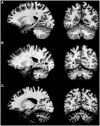Spinocerebellar Ataxia Type 2: Clinicogenetic Aspects, Mechanistic Insights, and Management Approaches
- PMID: 28955296
- PMCID: PMC5601978
- DOI: 10.3389/fneur.2017.00472
Spinocerebellar Ataxia Type 2: Clinicogenetic Aspects, Mechanistic Insights, and Management Approaches
Abstract
Spinocerebellar ataxia type 2 (SCA2) is an autosomal dominant cerebellar ataxia that occurs as a consequence of abnormal CAG expansions in the ATXN2 gene. Progressive clinical features result from the neurodegeneration of cerebellum and extra-cerebellar structures including the pons, the basal ganglia, and the cerebral cortex. Clinical, electrophysiological, and imaging approaches have been used to characterize the natural history of the disease, allowing its classification into four distinct stages, with special emphasis on the prodromal stage, which is characterized by a plethora of motor and non-motor features. Neuropathological investigations of brain tissue from SCA2 patients reveal a widespread involvement of multiple brain systems, mainly cerebellar and brainstem systems. Recent findings linking ataxin-2 intermediate expansions to other neurodegenerative diseases such as amyotrophic lateral sclerosis have provided insights into the ataxin-2-related toxicity mechanism in neurodegenerative diseases and have raised new ethical challenges to molecular predictive diagnosis of SCA2. No effective neuroprotective therapies are currently available for SCA2 patients, but some therapeutic options such as neurorehabilitation and some emerging neuroprotective drugs have shown palliative benefits.
Keywords: ataxin-2; autosomal dominant cerebellar ataxias; hereditary ataxias; polyglutamine expansions; spinocerebellar ataxia type 2.
Figures




Similar articles
-
ATXN2-AS, a gene antisense to ATXN2, is associated with spinocerebellar ataxia type 2 and amyotrophic lateral sclerosis.Ann Neurol. 2016 Oct;80(4):600-15. doi: 10.1002/ana.24761. Ann Neurol. 2016. PMID: 27531668 Free PMC article.
-
Generation of an Atxn2-CAG100 knock-in mouse reveals N-acetylaspartate production deficit due to early Nat8l dysregulation.Neurobiol Dis. 2019 Dec;132:104559. doi: 10.1016/j.nbd.2019.104559. Epub 2019 Jul 31. Neurobiol Dis. 2019. PMID: 31376479
-
Frequency of SCA1, SCA2, SCA3/MJD, SCA6, SCA7, and DRPLA CAG trinucleotide repeat expansion in patients with hereditary spinocerebellar ataxia from Chinese kindreds.Arch Neurol. 2000 Apr;57(4):540-4. doi: 10.1001/archneur.57.4.540. Arch Neurol. 2000. PMID: 10768629
-
A comprehensive review of spinocerebellar ataxia type 2 in Cuba.Cerebellum. 2011 Jun;10(2):184-98. doi: 10.1007/s12311-011-0265-2. Cerebellum. 2011. PMID: 21399888 Review.
-
[Advance in research on spinocerebellar ataxia 2].Zhonghua Yi Xue Yi Chuan Xue Za Zhi. 2018 Apr 10;35(2):284-287. doi: 10.3760/cma.j.issn.1003-9406.2018.02.032. Zhonghua Yi Xue Yi Chuan Xue Za Zhi. 2018. PMID: 29653012 Review. Chinese.
Cited by
-
The potential value of disease-modifying therapy in patients with spinocerebellar ataxia type 1: an early health economic modeling study.J Neurol. 2023 Aug;270(8):3788-3798. doi: 10.1007/s00415-023-11704-3. Epub 2023 Apr 19. J Neurol. 2023. PMID: 37076599 Free PMC article.
-
Conventional MRI findings in hereditary degenerative ataxias: a pictorial review.Neuroradiology. 2021 Jul;63(7):983-999. doi: 10.1007/s00234-021-02682-2. Epub 2021 Mar 17. Neuroradiology. 2021. PMID: 33733696 Free PMC article. Review.
-
Identification of the Prodromal Symptoms and Pre-Ataxic Stage in Cerebellar Disorders: The Next Challenge.Int J Environ Res Public Health. 2021 Sep 24;18(19):10057. doi: 10.3390/ijerph181910057. Int J Environ Res Public Health. 2021. PMID: 34639359 Free PMC article.
-
Dietary and lifestyle interventions for the management of hereditary ataxias.Front Nutr. 2025 Apr 24;12:1548821. doi: 10.3389/fnut.2025.1548821. eCollection 2025. Front Nutr. 2025. PMID: 40342369 Free PMC article. Review.
-
Autonomic function testing in spinocerebellar ataxia type 2.Clin Auton Res. 2018 Jun;28(3):341-346. doi: 10.1007/s10286-018-0504-4. Epub 2018 Feb 12. Clin Auton Res. 2018. PMID: 29435867 Free PMC article.
References
Publication types
LinkOut - more resources
Full Text Sources
Other Literature Sources
Research Materials

